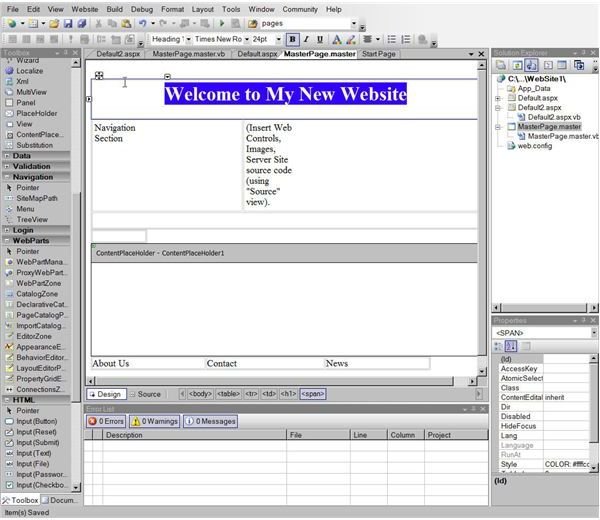

- ASP.NET DISPLAY MASTER PAGE ONLY UPDATE
- ASP.NET DISPLAY MASTER PAGE ONLY FULL
- ASP.NET DISPLAY MASTER PAGE ONLY CODE
The ASP.NET page’s markup contains a Content control for each of the ContentPlaceHolder controls defined in the So directive there’s a reference to the master page file used (Master PageFile=”~/Site.master”), and The master page can also contain code, allowing dynamic content. So The id attribute identifies the placeholder, allowing many placeholders The master page contains a placeholder tag for individual content. The Master directive defines it as a master page. So here Our master page has a single ContentPlaceHolder (MainContent), but mĪster pages may have multiple ContentPlaceHolders. These content editable regions are indicated by When users request the content pages, they merge with the master page to produce output that combines the layout of the master pageĪ master page defines both the static page layout and the regions that can be edited by the ASP MasterPage You can then create individual content pages that contain the content So A single master page defines the look and feels and standard behavior that you want for all of the pages (or a group of pages) in your application. so open your visual studio For more learn about the master page in asp net:- master page in asp netĪSP.NET master pages allow you to create a consistent layout for
ASP.NET DISPLAY MASTER PAGE ONLY FULL
With ASP.NET, the common way to hide sensitive information (database passwords,Įmail passwords, etc.In previously we already discuss the “ required field validation ”, “ Range validator ” & “Compared field validator” with a full description with practical solution checked it out now I show you the master page in asp net. If you want to prevent your content blocks or layout files from being viewed With ASP.NET, files with a name that starts with an underscore cannot be
ASP.NET DISPLAY MASTER PAGE ONLY CODE
Centralizing markup, style, and code makes webĪpplications much more manageable and easier to maintain. These tools also save you a lot of work, since you don't have to repeat the With two ASP.NET tools, Content Blocks and Layout Pages, you can give your Nostrud exercitation ullamco laborisnisi ut aliquip ex ea commodo consequat. Incididunt ut labore et dolore magna aliqua. Lorem ipsum dolor sit amet, consectetur adipisicing elit,sed do eiusmod tempor Same content in every page, and when you change the header or footer files, the Using common headers and footers as an example, this saves you a lot of work. With Web Pages you can use the method to import content from separateĬontent block (from another file) can be imported anywhere in a web page, andĬan contain text, markup, and code, just like any regular web page. Many websites have content that is displayed on every

You can have reusableīlocks of content (content blocks), like headers and footers, in separate files.Īlso define a consistent layout for all your pages, using a layout template With Web Pages this can be done very efficiently.

With Web Pages it is easy to create a web site with a
ASP.NET DISPLAY MASTER PAGE ONLY UPDATE
WP Tutorial WebPages Intro WebPages Razor WebPages Layout WebPages Folders WebPages Global WebPages Forms WebPages Objects WebPages Files WebPages Databases WebPages Helpers WebPages WebGrid WebPages Charts WebPages Email WebPages Security WebPages Publish WebPages Examples WebPages ClassesĪSP.NET Razor Razor Intro Razor Syntax Razor C# Variables Razor C# Loops Razor C# Logic Razor VB Variables Razor VB Loops Razor VB LogicĪSP Classic ASP Intro ASP Syntax ASP Variables ASP Procedures ASP Conditionals ASP Looping ASP Forms ASP Cookies ASP Session ASP Application ASP #include ASP Global.asa ASP AJAX ASP e-mail ASP ExamplesĪSP Reference ASP VB Functions ASP VB Keywords ASP Response ASP Request ASP Application ASP Session ASP Server ASP Error ASP FileSystem ASP TextStream ASP Drive ASP File ASP Folder ASP Dictionary ASP AdRotator ASP BrowserCap ASP Content Linking ASP Content Rotator ASP Quick RefĪDO Tutorial ADO Intro ADO Connect ADO Recordset ADO Display ADO Query ADO Sort ADO Add ADO Update ADO Delete ADO Demo ADO Speed UpĪDO Objects ADO Command ADO Connection ADO Error ADO Field ADO Parameter ADO Property ADO Record ADO Recordset ADO Stream ADO DataTypes


 0 kommentar(er)
0 kommentar(er)
